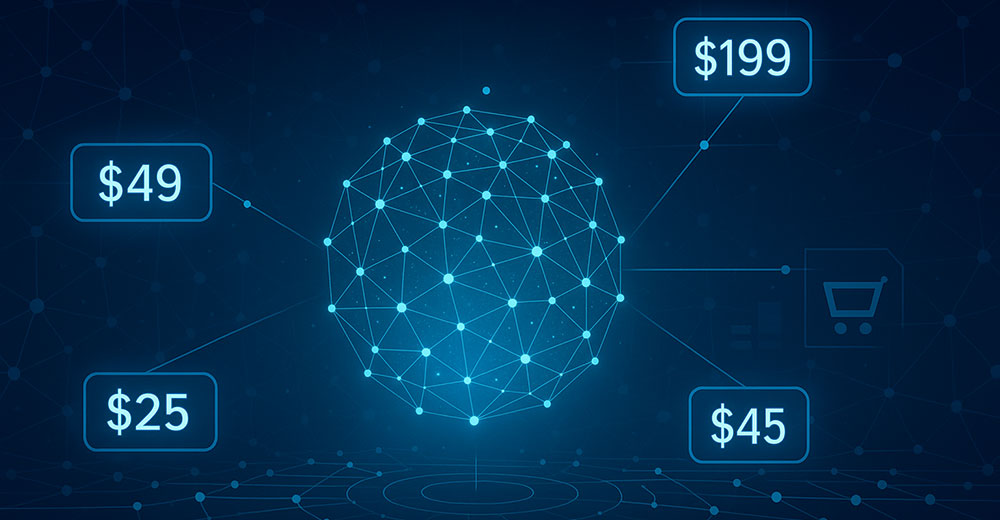
Picture this: It’s Black Friday 2027, and retail’s biggest “customer” isn’t a soccer mom hunting for deals or a Gen-Z trendsetter. It’s an AI agent representing 50,000 households, armed with aggregated purchasing power that would rival the largest enterprise procurement teams.
This agent is not looking at retailers’ brand stories, influencer partnerships, or carefully crafted emotional appeals. It is only looking for the best possible deal for its users, and it will increasingly have the data and negotiating power to identify those deals.
Welcome to the bot-to-bot economy, where AI agents will increasingly conduct autonomous transactions that may bypass traditional human-mediated commerce entirely.
When Bots Create the Bargains, Not Just Find Them
Table of Contents
The Aggregation Revolution
The global AI agent market is exploding, as protocols now enable AI agents to communicate, negotiate, and coordinate actions across enterprise platforms. Soon, AI intermediaries will be able to band together to barter and buy collectively without human intervention, creating economies of scale that capture better deals than individual purchases. This isn’t just comparison shopping or bargain hunting; it’s an entirely new marketplace dynamic.
Imagine 1,000 consumers each wanting a $500 carry-on suitcase for $400. Traditionally, retailers wouldn’t budge for individual customers, but when an AI agent aggregates this demand and approaches pricing algorithms with a guaranteed 1,000-unit order, suddenly that discount becomes both possible and profitable. The value equation changes dramatically when the “negotiations” and transactions can take place in milliseconds.
What’s unique is this: AI agents won’t just search for a bargain — instead, they can create one, armed with the leverage of guaranteed, bulk shopper demand. A seller bot, knowing the precise volume and its own inventory and margin thresholds, can agree to a price that would be unprofitable for a single customer but is lucrative for a thousand.
This innovation could create a brand-new category of commerce: demand-aggregated marketplaces. In these marketplaces, where AI agents pool consumer intent before approaching retailers, retail pricing strategies must adapt.
When volume discounts become accessible to individual consumers through collective AI bargaining, retail pricing strategies must account for algorithmic negotiation capabilities. Retailers’ traditional list prices will act more as opening positions or offers than as final sale prices in AI-driven negotiations.
This shift could change how brands spend their marketing dollars. Instead of putting money into campaigns that may or may not drive sales, brands could direct those funds toward the discounts their seller-bots are allowed to offer. In practice, that means marketers might swap ad spend for tiered discounts, letting bots negotiate prices with customers’ bots based on expected demand and bulk orders.
The consumer’s AI agent, not a beautifully designed website, app, or award-winning ad campaign, will become the trusted curator and gatekeeper for shopping decisions, which creates a jarring new customer experience.
The Infrastructure Is Already Here
The technical foundation for this transformation is solidifying rapidly. Emerging protocols allow agents to discover capabilities, manage tasks, collaborate securely, and negotiate user experience requirements. There are already companies doing the work — transforming enterprise procurement by using AI agents to conduct thousands of autonomous negotiations simultaneously with suppliers.
For this process to work, it is critical that retailers establish a robust transactional infrastructure to support it. Already, the market is seeing major payment providers betting big on this future. For example, one well-known provider launched an agentic payment option that allows for agentic commerce.
The mechanics of this new marketplace, now underway, are highly sophisticated compared to what most retailers are used to.
Internet commerce works on the principle that buyers will broadcast needs and sellers will respond. The magic of marketing has been aligning campaigns to match anticipated buyer intentions and demand. If the holiday travel season is coming up, promote the newest $500 carry-on bag.
Within a demand-aggregated marketplace, bots can predict consumer intentions before they even decide what to buy, creating a market for intent signals.
Take this scenario: buyer-bots pool identical customer intents across thousands of users, then auction or “sell” those pooled orders to seller-bots — working on behalf of the retailer — that can profitably meet the price at volume. In this future, retailers may even be able to “create” customers by offering bulk-discounted prices that bring in consumers who would not have bought the carry-on bag at the $500 price.
Bots aren’t just buying products — they’re helping design them. See how retailers are co-creating with AI.
The Many Facets of the Customer Experience Revolution
Hyper-Personalization Meets Invisible Commerce
AI shopping assistants are now capable of browsing products, comparing options, and completing purchases autonomously, analyzing preferences, and applying discounts to create personalized experiences that adapt to individual behaviors. According to Shopify, 73% of shoppers say AI improves their shopping experience.
For consumers, the upside is a world of unprecedented convenience and proactive service. AI agents can reorder consumers’ favorite coffee before they run out, negotiate group discounts with neighbors, and find hard-to-discover deals. No more comparison shopping, reading reviews, or hunting for coupon codes as AI personal agents can handle it all in the background.
There will also be an added layer of transparency as automated quotes could include shipping emissions, return considerations, and warranty complications — all attributes that AI will weigh explicitly instead of being lost in fine print, further ensuring personal preferences and addressing each shopper’s values with every purchase.
Understanding Potential Risks
Automated commerce also comes with risks for retailers. If AI agents focus only on metrics, years of brand building may matter less in purchase decisions. Shoppers may miss out on the chance to discover new products as agents prioritize efficiency and AI-optimized content over bold new campaigns. And because these systems rely on large amounts of behavioral data, they raise new privacy and bias concerns.
Brands will need to make data protection and compliance a top priority, while also watching for biases that can skew recommendations, outputs, and pricing in unintended ways. To prevent issues with the data, it is important that retailers keep a human in the loop and assign a member of the team to oversee training data.
Is your AI fair — or just fast? Explore how retailers are tackling fairness and transparency in machine learning.
Reshuffling of Loyalties
As the market changes, retailers will have to learn how to optimize content for AI bots to crawl and include their products in searches. This forces a redefinition of brand value. In the bot economy, brand equity may shift from intangible human perception to tangible machine performance. Attributes that were once back-end technical details — like API latency, data quality, and security protocols — become front-and-center brand differentiators.
Perhaps the most fascinating aspect of the bot economy isn’t what it automates, but what it makes unexpectedly valuable. As AI agents reshape commerce, they may create new forms of brand loyalty due to their service premiums. Households could become loyal to their buyer-bots over the brands they used to love. This means shoppers no longer associate their loyalty with certain logos or stores, but rather their helpful AI agent becomes the trusted source.
Yet not every business model can survive a paradigm shift this profound. The companies that fail to adapt are likely to be those that have built their competitive advantage on the inefficiencies that AI agents are now designed to eliminate.
A prime example of this: comparison sites, deal platforms, and other intermediaries. Also, retailers competing primarily on emotional brand appeal rather than functional advantage are also at risk, as AI agents prioritize measurable performance metrics over marketing appeal. The same is true for those competing purely on price, as AI agents will make it hard to beat in the race to the bottom.
Going forward, retailers must navigate a web of changes from enhanced data privacy needs, to updating API systems, and establishing bot-friendly interfaces, all in an effort to remain competitive in an AI economy.
The Strategic Imperative To Act Now
While all of this may sound otherworldly, a bot-to-bot economy isn’t a distant future scenario. It is emerging now. If the last decade was the battle for consumer attention, the next will be the battle for consumer intent that is discovered, negotiated, and settled by AI agents.
For retail executives, this creates a narrow window of opportunity. The companies that invest now in agentic AI-compatible infrastructure, data quality, and algorithmic capabilities will be better positioned to compete tomorrow and help redefine the future of commerce.
Is your retail strategy built for a world where AI agents call the shots? Prepare for the next era — contact us today.





